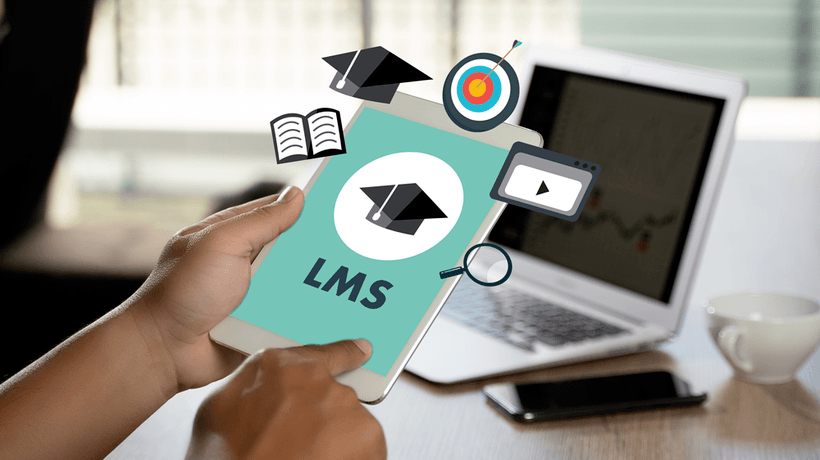Imagine a school where administrative tasks, student data, and course materials are seamlessly connected. This is what integration between School Management Software and Learning Management Systems can achieve.

Integrating School Management Software (SMS) With LMS
Technology today plays a significant role in enhancing the learning experience. School Management Software, also known as SMS, and Learning Management Systems (LMS) have emerged as indispensable tools for schools.
In this blog, we will delve into the significance of integrating SMS with LMS and how this integration can streamline educational operations and improve the overall learning environment.
Understanding School Management Software (SMS) and LMS: A Comprehensive Overview
School management software is a digital tool or application designed to streamline and automate various administrative and academic tasks in educational institutions, such as schools, colleges, and universities. It typically includes features for:
- Student Information Management: Storing and managing student records, attendance, grades, and personal details.
- Attendance Tracking: Recording and monitoring student and staff attendance.
- Gradebook and Assessment: Managing grades, assignments, exams, and generating report cards.
- Timetable and Scheduling: Creating and managing class schedules, teacher timetables, and room assignments.
- Communication: Facilitating communication between teachers, students, and parents through messaging and notifications.
- Fee and Finance Management: Managing fee collection, financial transactions, and budgeting.
- Reporting and Analytics: Providing insights through reports and data analysis.
- Online Learning Integration: Some modern school management software, like SchoolTry, for example, includes features for online learning and virtual classrooms.
These software systems aim to improve the efficiency of educational institutions, reduce paperwork, enhance communication, and provide data-driven insights for decision-making.
Understanding Learning Management Systems (LMS): A Comprehensive Overview
A Learning Management System (LMS) is a platform designed to help educators and organizations manage, deliver, and track educational content and training programs.
These systems provide tools for creating, organizing, and delivering courses, as well as monitoring and assessing the progress of learners. They are commonly used in schools, universities, and businesses for online education, training, and skill development.
Why Integration Matters
Imagine a school where administrative tasks, student data, and course materials are seamlessly connected. This is what integration between SMS and LMS can achieve.
Essentially, it’s the bridge that connects the back-end management of educational institutions with the front-end learning and teaching processes.
Let’s take a closer look at the benefits of Integrating school management software with learning management systems.
Benefits of Integrating School Management Software With Learning Management Systems
There are numerous benefits of Integrating School Management Systems with LMS. These include streamlined data management, improved communication, enhanced learning experience, and data-driven decision-making, to name a few. Let’s explore these benefits in more detail.
01. Streamlined Data Management
By integrating SMS and LMS, schools can streamline data management. Administrative tasks such as enrollment, attendance tracking, and grade recording become more efficient. This not only saves time but also reduces the chances of errors.
02. Improved Communication
Integration allows for improved communication between students, teachers, and administrators. Updates on assignments, schedules, and important announcements can be instantly shared through the LMS, ensuring everyone is on the same page.
03. Enhanced Learning Experience
Students benefit from a more seamless learning experience. They can access course materials, submit assignments, and receive feedback within the LMS. This accessibility empowers learners, making education more engaging and interactive.
04. Data-Driven Decision-Making
Integrated systems provide a wealth of data that can be analyzed to make informed decisions. From student performance analytics to resource allocation, educators and administrators can use this data to refine their strategies.
Steps to Integrate SMS with LMS
To achieve these benefits, it’s essential to follow a structured approach:
01. Selecting the Right SMS and LMS
Choose SMS and LMS systems that are compatible and meet the specific needs of your institution. It’s crucial to ensure they can work together seamlessly.
02. Data Synchronization
Ensure that student data, course information, and other relevant data are synchronized between the two systems. This eliminates the need for manual data entry and reduces the chances of errors.
03. Customization and Configuration
Tailor the integration to match your institution’s unique requirements. This may involve configuring settings, customizing dashboards, and ensuring that both systems are in sync with your workflow.
04. Training and Onboarding
Proper training and onboarding of staff and students are critical. Everyone involved must understand how to use the integrated systems effectively.
Security and Privacy Concerns
Integrating systems means dealing with sensitive student and staff data. It’s crucial to prioritize security and privacy.
Future Trends and Innovations
The future of SMS and LMS integration is promising.
Emerging technologies, such as Artificial Intelligence (AI) and advanced analytics, are poised to further enhance the learning experience and administrative efficiency.
Conclusion
Integrating School Management Software with Learning Management Systems is a significant step towards creating a more efficient and effective educational ecosystem.
It streamlines operations, improves communication, enhances the learning experience, and empowers data-driven decision-making.
As technology continues to evolve, educational institutions should embrace integration to stay ahead in the ever-changing world of education.




